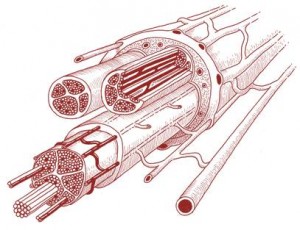Is it Possible to Regenerate Nerves via Hydro-dissection and the Regenexx-PL Procedure?
We’ve been very cautious around nerves for obvious reasons. We haven’t used traditional stem cells around nerve injuries because of our concern that getting stem cells to differentiate into nerve cells is much tougher than for traditional orthopedic applications. Instead, we’ve focused on using our proprietary platelet lysate technology to help patients with irritated spinal nerves from herniated and bulging low back discs. This procedure avoids using bloody platelet rich plasma that might cause too much swelling around nerves and instead focuses on using a growth factor cocktail where the platelets are broken open in our lab to concentrate all of their cargo. We’ve had great success through the years helping patients get rid of sciatica by using their own natural growth factors and without using the toxic high dose steroids everyone else uses. But can we do more? Dr. Hanson had done some work in his last position using saline to break up scar tissue around nerves under ultrasound guidance. This is known as hydro-dissection. When he joined us he began to use platlet lysate because of our success with epidural injections. He noticed pretty remarkable effects in treating carpal tunnel syndrome and entraped ulnar nerves at the elbow. But can we do more? We recently treated a patient who regrettably had his femoral nerve injured with a nerve block while undergoing a knee replacement. He had tragically lost much of the strength in his qaudriceps muscle. 10 months into this nightmare, there was little hope of much nerve recovery. As a result we discussed with the patient whether he wanted to try the Regenexx PL procedure to attempt to regenerate nerves via hydro-dissection on the obviously constricted area of his femoral nerve as observed on ultrasound. He literally didn’t have much to lose. Two months after the procedure, here’s the phone message he just left:
“He was able to lift his leg when pre procedure he was not able to do leg lifts. He has been doing home exercises and lift the right leg, then the left leg and was amazed that he could do so. He did it again just to see if he could, which he was able to. It has been aprox. 10 months without the ability to do leg lifts. He does have a “aching pain” that comes and goes that is in the inner thigh it comes for an hour and disapates. At this time he doesn’t find it something that bothers him too much. He just wanted to update that he could do leg lifts post-procedure. New improvement!”
Is this possible? Could he be getting more motor function in the quadriceps muscle not only because the hydro-dissection released the scar tissue from the initial block injury, but also because we were able to grow new blood supply around the nerve? It’s known that the growth factors in platelets can regrow blood vessels and that nerves are surrounded by critical blood vessels that keep them healthy. Could the platelet lysate establish new and much needed nerve blood supply? We’re cautiously optomistic about this one and will likely be pulling the trigger on a more formal study. The upshot? This could be very interesting in helping patients who have few good options…

If you have questions or comments about this blog post, please email us at [email protected]
NOTE: This blog post provides general information to help the reader better understand regenerative medicine, musculoskeletal health, and related subjects. All content provided in this blog, website, or any linked materials, including text, graphics, images, patient profiles, outcomes, and information, are not intended and should not be considered or used as a substitute for medical advice, diagnosis, or treatment. Please always consult with a professional and certified healthcare provider to discuss if a treatment is right for you.
